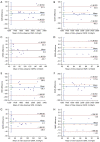Evaluation of left ventricular myocardial work in patients with hyperthyroidism with different heart rates with noninvasive pressure-strain loop based on two-dimensional speck tracking imaging
- PMID: 37064400
- PMCID: PMC10102738
- DOI: 10.21037/qims-22-534
Evaluation of left ventricular myocardial work in patients with hyperthyroidism with different heart rates with noninvasive pressure-strain loop based on two-dimensional speck tracking imaging
Abstract
Background: We investigated the application value of no-invasive myocardial work in evaluating left ventricular (LV) function in patients with hyperthyroidism.
Methods: Sixty-five patients with an initial hyperthyroidism diagnosis were sorted into tachycardia (group TH1, n=31) and without tachycardia (group TH2, n=34) groups. Thirty healthy participants served as the control group (group CON). LV strain parameters and LV myocardial work parameters were evaluated at rest. Each parameter's value in identifying myocardial damage was analyzed using receiver operating characteristic curves. The correlation of myocardial work parameters with global longitudinal strain (GLS), longitudinal peak strain dispersion (normalized by heart rate, PSDN), and systolic blood pressure (SBP) was analyzed.
Results: There was no difference in classic echocardiographic parameters between the groups. Compared with that in group CON, GLS decreased in groups TH1 and TH2 (TH1 17.99%±2.21% and TH2: 19.00%±2.85% vs. 20.27%±1.49%; both P<0.05); there was no significant difference between groups TH1 and TH2. PSDN increased in groups TH1 and TH2 (TH1 73.13±19.51 ms and TH2 55.06±17.03 vs. 44.13±8.65 ms; both P<0.05); it was higher in group TH1 than in group TH2 (P<0.05). Myocardial global work efficiency (GWE) decreased in groups TH1 and TH2 {TH1 95% [interquartile range (IQR), 94-95%] and TH2 96% (IQR, 95-97%) vs. 97% (IQR, 96-97%); both P<0.05}; it was lower in group TH1 than in group TH2 (P<0.05). Global constructive work (GCW) decreased in group TH1 (1,865.29±284.13 vs. 2,030.33±252.52 mmHg%; P<0.05), but was not different from that in group TH2; there was no difference between groups TH2 and CON. Global wasted work (GWW) increased in groups TH1 and TH2 [TH1 83.00 (IQR, 74.00-97.00) mmHg% and TH2 69.50 (IQR, 51.25-84.25) vs. 50.50 (IQR, 40.75-65.25) mmHg%; both P<0.05]; it was higher in group TH1 than in group TH2 (P<0.05). The area under the GWE curve was the largest (area under the curve =0.835), and the optimal cutoff point was 96.5%, with a sensitivity of 0.83 and a specificity of 0.70. GWE and GCW were positively correlated with GLS and negatively correlated with PSDN. GWW was negatively correlated with GLS and positively correlated with PSDN. In group CON, GCW and GWW were positively correlated with SBP; GWE was not correlated with SBP. In groups TH1 and TH2, GCW was positively correlated with SBP, but not with GWW or GWE.
Conclusions: Hyperthyroidism can significantly decrease the GWE and increase GWW of the left ventricle. This change is more pronounced in patients with tachycardia. Myocardial work could be a novel method for the evaluation of LV myocardial function in patients with hyperthyroidism.
Keywords: Hyperthyroidism; left ventricle; myocardial work; pressure-strain loop; tachycardia.
2023 Quantitative Imaging in Medicine and Surgery. All rights reserved.
Conflict of interest statement
Conflicts of Interest: All authors have completed the ICMJE uniform disclosure form (available at https://qims.amegroups.com/article/view/10.21037/qims-22-534/coif). The authors have no conflicts of interest to declare.
Figures




Similar articles
-
Correlation between myocardial work and disease activity in rheumatoid arthritis patients with preserved left ventricular ejection fraction: a retrospective study based on non-invasive pressure-strain loop:.Clin Rheumatol. 2025 Apr;44(4):1513-1525. doi: 10.1007/s10067-025-07380-5. Epub 2025 Mar 5. Clin Rheumatol. 2025. PMID: 40042530 Free PMC article.
-
Value of quantitative analysis of left ventricular systolic function in patients on maintenance hemodialysis based on myocardial work technique.BMC Cardiovasc Disord. 2021 Feb 6;21(1):76. doi: 10.1186/s12872-021-01899-6. BMC Cardiovasc Disord. 2021. PMID: 33549050 Free PMC article.
-
Quantitative assessment of left ventricular myocardial work in patients with different types of atrial fibrillation by non-invasive pressure-strain loop technique.Echocardiography. 2024 Mar;41(3):e15801. doi: 10.1111/echo.15801. Echocardiography. 2024. PMID: 38519840
-
Assessing Myocardial Strain and Myocardial Work as a Marker for Hypertensive Heart Disease: A Meta-Analysis.Rev Cardiovasc Med. 2023 Jul 31;24(8):217. doi: 10.31083/j.rcm2408217. eCollection 2023 Aug. Rev Cardiovasc Med. 2023. PMID: 39076705 Free PMC article.
-
Echocardiography myocardial work assessment of chemotherapy-induced cardiotoxicity: a systematic review and meta-analysis.Med Ultrason. 2025 Mar 24. doi: 10.11152/mu-4502. Online ahead of print. Med Ultrason. 2025. PMID: 40146979 Review.
Cited by
-
Correlation between myocardial work and disease activity in rheumatoid arthritis patients with preserved left ventricular ejection fraction: a retrospective study based on non-invasive pressure-strain loop:.Clin Rheumatol. 2025 Apr;44(4):1513-1525. doi: 10.1007/s10067-025-07380-5. Epub 2025 Mar 5. Clin Rheumatol. 2025. PMID: 40042530 Free PMC article.
-
Application of the Left Ventricular Pressure-Strain Loop Technique in Monitoring Improvement Factors of Patients With Heart Failure Reduced Ejection Fraction.Cardiovasc Ther. 2024 Dec 17;2024:5562513. doi: 10.1155/cdr/5562513. eCollection 2024. Cardiovasc Ther. 2024. PMID: 39742018 Free PMC article.
-
Transient decline and early recovery of noninvasive myocardial work after kidney transplantation: a prospective study.Ren Fail. 2025 Dec;47(1):2543930. doi: 10.1080/0886022X.2025.2543930. Epub 2025 Aug 11. Ren Fail. 2025. PMID: 40789763 Free PMC article.
-
Impairment of Left Ventricular Function in Hyperthyroidism Caused by Graves' Disease: An Echocardiographic Study.J Clin Med. 2024 Dec 2;13(23):7348. doi: 10.3390/jcm13237348. J Clin Med. 2024. PMID: 39685806 Free PMC article.
References
-
- Ponikowski P, Voors AA, Anker SD, et al. 2016 ESC Guidelines for the diagnosis and treatment of acute and chronic heart failure: The Task Force for the diagnosis and treatment of acute and chronic heart failure of the European Society of Cardiology (ESC)Developed with the special contribution of the Heart Failure Association (HFA) of the ESC. Eur Heart J 2016;37:2129-200. 10.1093/eurheartj/ehw128 - DOI - PubMed
LinkOut - more resources
Full Text Sources
Miscellaneous
